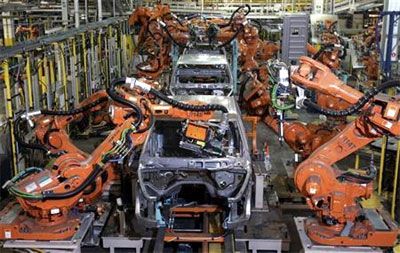 | « Back to article | Print this article |
An average of 30-40 per cent automation is standard across all big automobile plants in the country
 Over 400 robots work in Hyundai’s Sriperumbudur factory. The largest car exporter from India has invested Rs 600 crore (Rs 6 billion) since 2010 in its plant. Some tasks like welding and painting are fully automated but Hyundai says automation is lower in others, like 10 per cent in the assembly shop.
Over 400 robots work in Hyundai’s Sriperumbudur factory. The largest car exporter from India has invested Rs 600 crore (Rs 6 billion) since 2010 in its plant. Some tasks like welding and painting are fully automated but Hyundai says automation is lower in others, like 10 per cent in the assembly shop.
Having a few hundred robots in a car factory is not uncommon. Ford’s newly inaugurated Sanand plant in Gujarat has 437 robots. The level of plant automation is 30 per cent but it rises to 95 per cent in the body shop.
The Tata Motors plant in Sanand making the Nano, touted as the world’s cheapest car, uses close to 100 robots. The country's largest car maker, Maruti Suzuki, has more than 1,000 robots working in its plants at Gurgaon and Manesar.
According to the International Federation of Robotics, robot installations globally will increase by 12 per cent a year on average between 2015 and 2017. The growth will be six per cent in the Americas and Europe and 16 per cent in Asia and Australia. While the bulk of the Asian growth will come from China and Japan, India is moving towards increasing automation, especially in car making.
Sector watchers say if the trend continues for another five years, it will affect employment. Increase in foreign direct investment (FDI) in the automobile sector is the main reason for rising automation. A recent Frost & Sullivan analysis shows FDI in the sector rose from $200 million in 2009-10 to $646 million in 2013-14.
An average of 30-40 per cent automation is standard across all big automobile plants in the country, says Abdul Majeed, partner, PwC India.
Original equipment manufacturers (OEMs) contacted across various automobile manufacturing clusters say automation improves productivity and quality, but industry insiders maintain there is an element of de-risking labour issues as well.
“OEMs have been pushed to think about automation in the backdrop of labour issues. The country’s archaic labour laws need a change,” say Majeed.
“Labour troubles have encouraged companies to think of productivity and cost per labourer,” adds Vishnu Mathur, director-general at the Society of Indian Automobile Manufacturers (Siam). In some cases, the precision required is difficult to achieve through human intervention, he adds.
Car makers, however, do not see automation as a threat to employment. “Automation may be eliminating some jobs in some places, but overall with a company on a growth path, you create a whole lot of other jobs. Automation by itself does not reduce jobs,” says Vairamani Pandiyan, vice-president for human resources at Ford India.
“If you walk into our Chennai plant, which is older than the Sanand plant, you will find increased automation compared with five years ago. But the overall number of employees has gone up,” he adds.
For companies like Maruti Suzuki, which makes 1.5 million cars a year, it makes to invest in automation, expensive and viable only when sales are high.
“Indian manufacturers have adopted a novel approach, ‘autonomation’, a judicious mix of people and machines. Plus, low-cost automation has also picked up," says Mathur.
A Maruti Suzuki executive says the company’s engineers have developed in-house robotic solutions for some processes that needed automation. This reduces cost by cutting down on expensive imports. The sector also highlights Indian automobile manufacturers will take time to switch completely to automation because that would wipe out the advantage of cheap labour. A Honda Motorcycle and Scooter India executive says the company has been increasing automation in its new plants but it has not cut down on labour.
“A Volkswagen built in Pune with only 30 per cent automation is accepted on quality across Asia, Africa and North America,” claims Andreas Lauenroth, executive director, technical, Volkswagen India. “To put things in perspective, the body shop at our Pune facility is about 30 per cent automated while that in Wolfsburg is over 90 per cent. This difference is because the workforce is much more affordable in India than in Germany,” he adds.
British construction equipment player JCB claims its products manufactured in India can be used in any part of the world. “Automated lean manufacturing processes with no-faults forward systems are the drivers for manufacturing technology,” says Vipin Sondhi, managing director and chief executive officer, JCB India.
In 2013, Japan had 1,520 robots for 10,000 workers in the automobile industry, Germany 1,140, the US 1,111 and China 281. The International Federation of Robotics says China will have 428,000 robots in its production plants by 2017, more than any other country as carmakers race to build plants in the face of wage inflation.
"Investment in machines provides fixed returns, as the cost is recovered over a period of time, which is not the case for labour. Labour costs escalate, and also come with endless wage negotiations," says an automobile industry executive.
“India has the cheap labour advantage, and it is unlikely multinational firms would like to lose out on cost arbitrage. Perhaps more productivity will create more downstream jobs,” Majeed points out. Mathur, however, warns increased use of machines may not lead to huge job loss, but incremental job creation will slow down. The Indian automobile industry employs close to 20 million people.